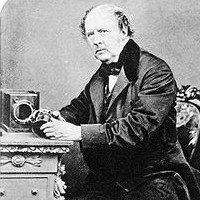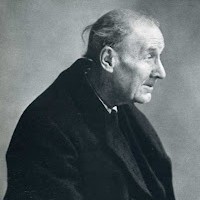|

Portrait of the photographer and
camera artist William Fox Talbot
in 1864.

A very unflattering portrait of the
great French photographer
Eugene Atget - chronicler of late
19th century Paris architecture.
|
List of the Top 80
Most Famous 19th-Century Photographers
Here is a short list of the greatest
photographers of the nineteenth century.
Antoine Samuel Adam-Salomon (1811-81)
Born in France, Adam-Salomon began life as a sculptor and carried his
artistic talents - some say excessively - into his photography. A great
believer in draping, side-lighting, and retouching, he collaborated with
Carjat, Nadar, and others, in the seven volumes of the Galerie des
Contemporains published in France in the 1850s.
Robert Adamson (1821-48)
The name of Robert Adamson, who was born near St. Andrews in 1821, is
inseparably linked with that of David Octavius Hill. During his short
life, Adamson made, in conjunction with Hill, over 1500 calotypes of Scottish
notables, workers, and genre scenes, assuming responsibility for the photographic
technique. Adamson's technical skill was a perfect foil for Hill's artistry,
and calotypes produced by the two men remain unequalled.
Giuseppe Alinari (1836-90) Leopoldo
Alinari (died 1865)
The firm of Alinari Brothers was founded in Florence in 1834 and quickly
established itself among Italy's leading photographers. Alinari made many
thousands of large (12x16") albumen prints of European churches,
historic buildings, and art treasures. The firm also produced a number
of cartes-de-visite. Alinari prints sometimes bear the name Bardi, the
printsellers' financier.
James Anderson (Isaac Atkinson)
(1813-77)
James Anderson was born in Cumberland and spent most of his working life
in Italy, first as a sculptor but by 1849 as a professional photographer.
Anderson produced many hundreds of commercial photographs of Rome and
art objects in Italian museums. He died in Rome in 1877. The family firm
survived until the 1960s.
James Craig Annan (1864-1946)
James Craig Annan, the son of Thomas Annan was born in Hamilton, Scotland,
in 1864. He trained in his father's studio and was responsible for making,
in 1890, copy prints of the work of Hill and Adamson and introducing them
to the USA and Europe.
Thomas Annan (1829-87)
A leading Scottish portrait and landscape photographer, Annan worked for
many years in Glasgow, producing photographically illustrated books and
a record of the Glasgow slums for the Glasgow City Improvement Trust.
A limited edition of the Glasgow slum photographs was issued in 1878.
Ottomar Anschutz (1846-1907)
Like Muybridge, Anschutz experimented with instantaneous photography,
producing excellent photographs of birds and animals at the Breslau Zoo.
In 1886 he used Muybridge's system of 24 linked cameras to photograph
German military manoeuvres and troops marching. For the purpose of improving
military training methods, Anschutz developed his tachyscope in 1887,
which was a type of zoetrope with a cylinder mounted on a horizontal axis,
using 24 images which, when rotated, gave an impression of movement.
Edward Anthony (1818-88)
Anthony undertook, in 1841, the first photographic survey to be commissioned
by the American Government, a survey of the North-East frontier with Canada.
A year later, in 1842, he opened, in partnership with Jonas Edwards, a
portrait studio in Washington, where in 1843 he photographed the members
of Congress. Anthony founded, with his brother, H.T.Anthony, a photographic
supply house, which produced and sold, in 1859, among other things stereoscopic
views of New York.
Eugene Atget
(1856-1927)
A dedicated man, who died in poverty after spending nearly thirty years
photographing the changing face of Paris, Atget was sadly neglected during
his lifetime. Since 1930, however, when a selection of his photographs
was published, the importance of his unique form of street
photography has become increasingly regarded as a record of Parisian
architecture in the late 19th and early 20th centuries. See also: Victorian
architecture of the late 19th century.
Edouard Baldus (1820-82)
Born in Germany in 1820, Baldus worked in France and became a French citizen.
Apart from photographing landscapes and Alpine views, Baldus produced
thousands of calotypes and wet plate photographs of Paris and its monuments,
statues, and art objects. Like many others who made large prints, Baldus
was adversely affected by the growing popularity of the cheap carte-de-visite
and retired from photography.
George N. Barnard (1819-1902)
George Barnard, who used the daguerreotype process, was one of the team
of 15 photographers employed by Mathew Brady to record the American Civil
War, and in 1866 accompanied General Sherman on his march through Georgia.
In 1865 he published an album of documentary
photography as a record of the campaign under the title Photographic
views of Sherman's campaign.
H. Walter Barnett (1862-1934)
After working for a number of years in Australia and America, Barnett
settled in England, opening a portrait studio at Hyde Park Corner. An
ability to make the best of his sitters, and especially society women,
who flocked to his studio, brought Barnett international fame.
William Barraud (1810-90)
Best remembered for his two volumes of Men and Women of the Day,
published in 1888-89, Barraud took cabinet portraits of many famous Victorian
statesmen, artists, and members of the aristocracy.
Hippolyte Bayard (1801-87)
A portrait and landscape photographer, Bayard was an early experimenter
with photography, and he was able, in 1839, to produce positive photographs
on paper. Bayard did not make his process public, however, until 1840,
thus forfeiting recognition as one of the earliest inventors of photography.
Bayard never became a professional photographer, preferring to keep his
amateur status and using, at one time or another, almost all the known
photographic processes. He was for 15 years, from 1866-1881, the Honorary
Secretary of the Societe Francaise de Photographie.
Richard Beard (1802-88)
Although it is probable that Beard, who started his working life as a
coal merchant in London, never personally took a photograph, he deserves
a place here as one of the first, and possibly the greatest, entrepreneurs
of photography. He was responsible for the commercial realization of many
photographic advances, including the enlarger, the shortening of exposure
times, and the hand colouring of daguerreotypes. In 1841 Beard opened
England's first public photographic studio in London.
Felice A. Beato (1832-1909)
Best known as a war photographer who took gruesome photographs of the
Opium War of 1860, Beato travelled extensively in the Near and Middle
East before going to the Crimea with Robertson. In 1860 he went to China
and photographed the Opium War. In 1885 he covered the campaign in the
Sudan, which led to the unsuccessful attempt to relieve General Gordon
at Khartoum.
Francis Bedford (1816-94)
A noted topographical photographer, Bedford produced consistently good
photographs of English cathedrals, castles, monuments, and landscape scenes,
often as cartes-de-visite or stereoscopic prints. In 1862 he recorded
the tour of the Prince of Wales to the Middle East.
Louis Auguste Bisson (1814-76) Auguste
Rosalie Bisson (1826-1900)
After opening, in 1841, one of the first daguerreotype studios in Paris
under the name of Bisson Freres, the brothers visited Switzerland in 1860
as part of the entourage of the Empress Eugenie and there produced some
of the earliest and most splendid Alpine photographs in the history of
photography. Bisson Freres are equally famous for their photographs of
French and Italian churches and cathedrals, and their early portraits.
Samuel Bourne (1834-1912)
He photographed scenes in India, Kashmir, and the Himalayas during the
1860s and 1870s, overcoming innumerable mishaps and difficulties in order
to do so. Bourne later opened photographic studios in Bombay, Calcutta,
and Simla.
Mathew Brady (1823-96)
Mathew Brady, one of the best known American photographers of the 19th
century, became a professional in 1844 and was soon much sought after
for his fine portraits, although of over 30,000 photographs produced by
his firm in 1861 less than 100 are attributed to Brady himself. When the
American Civil War broke out, Brady gathered together a team of photographers
and recorded the conflict for posterity. Unlike Fenton and Robertson in
the Crimea, Brady and his team did not hesitate to show the horrors of
war. Six thousand of his team's negatives were purchased by the War Department
in 1875, and they form a comprehensive record of the America of those
years.
Caldesi & Co
Born in Italy, Caldesi lived and worked in England. In partnership with
Montecchi and later with Blandford, Caldesi produced many early photographs
of art treasures in English collections; among his best known are the
Photographs of the Gems of the Art Treasures Exhibition, held in
Manchester in 1857, and his Photographic Historical Portrait Gallery,
published by Colnaghi in 1864. In the 1860s Caldesi and his partners also
produced carte-de-visite portraits.
Henry Herschel Hay Cameron (1852-1911)
Was the youngest son of Julia Margaret Cameron. As might be expected he
was greatly influenced by his mother's style, producing portraits of actors
and celebrities. Lewis Carroll once said of him that he was the only professional
photographer who dared to produce a portrait which was exactly like the
original. Cameron opened a studio in London but later gave up photography
in order to become an actor.
Julia
Margaret Cameron (1815-79)
Julia Margaret Cameron was born in India and was the mother of six children;
she was introduced to photography by her daughter in 1863 and threw herself
into this new hobby with characteristic enthusiasm. Mrs Cameron was, without
doubt, one of the most fascinating figures in the whole history of photography.
During the latter half of her life she produced, using soft focus and
close up, some of the greatest portrait studies of all time, studies that
can only be faulted for her habit of sentimentalizing her sitters and
her lack of care and skill in developing and processing. (See also: Pictorialism.)
Despite these faults, it is generally acknowledged that her best portraits
are unequalled and today they are eagerly sought after by collectors.
In 1875 Mrs Cameron illustrated, with a series of oddly posed photographs,
Tennyson's Idylls of the King, a glance at which confirms the superiority
of her portraits over her attempts at posing groups of people to illustrate
a story.
Note: From its invention in the 1830s,
photography has been dogged by issues of aesthetics
and by its relationship to other types of fine art, notably painting.
Even today, art critics continue to
debate the question: Is Photography
Art?
Etienne Carjat (1828-1906)
Carjat started his career in caricature
art, a genre that he followed for ten years. It was once said of his
photographic technique: "He does not torture them, dislocate their
necks, distort their arms or legs ... he only asks them to strike a natural
pose." Carjat, who worked in Paris, photographed many famous people;
among his best portraits are those of Baudelaire and Sarah Bernhardt.
Antoine Claudet (1797-1867)
Born in France, he lived for most of his life in England. In 1841 he vastly
improved Daguerre's process by reducing the time of exposure and later
made a number of other contributions to photography. Among these were
the use of painted backgrounds and the dark room light. He was appointed
photographer to Queen Victoria in 1853. As well as daguerreotype portraits,
Claudet produced many stereoscopic photographs.
|
![]()